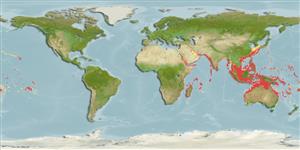Common names from other countries
Environment: milieu / climate zone / depth range / distribution range
экология
морской; солоноватоводный ассоциированный с рифами; пределы глубины 2 - 178 m (Ref. 86942), usually 15 - 75 m (Ref. 9710). Tropical; 30°N - 35°S
Indo-Pacific: East Africa and Persian Gulf to the Society Islands, north to southern Japan, south to Lord Howe Island. Throughout Micronesia.
Size / Вес / Возраст
Maturity: Lm ? range ? - ? cm
Max length : 25.0 cm TL самец/пол неопределен; (Ref. 5372); common length : 15.0 cm TL самец/пол неопределен; (Ref. 5450)
колючие лучи спинного плавника (общее число) : 11 - 12; членистые (мягкие) лучи спинного плавника (общее число) : 22 - 27; колючие лучи анального плавника: 3; членистые (мягкие) лучи анального плавника: 17 - 19.
Inhabit deep, protected lagoons and channels, and the deeper parts of outer reef slopes. Juveniles are often solitary while adults occur in pairs (Ref. 1602, 48636). A planktivorous species that generally remains within a few meters of the reef. Juveniles may sometimes pick on parasites on the epidermis of other fish (Ref. 5503). Oviparous (Ref. 205). Form pairs during breeding (Ref. 205).
Life cycle and mating behavior
Maturities | размножение | Spawnings | Egg(s) | Fecundities | личинки
Form pairs during breeding (Ref. 205).
Steene, R.C., 1978. Butterfly and angelfishes of the world. A.H. & A.W. Reed Pty Ltd., Australia. vol. 1. 144 p. (Ref. 4859)
Статус Красного Списка МСОП (Ref. 130435)
CITES (Ref. 128078)
Not Evaluated
Угроза для людей
Harmless
Использование человеком
рыболовство: не имеет хозяйственного значения; аквакультура (рыбоводство): коммерческий; аквариум: коммерческий
дополнительная информация
инструменты
Специальные отчеты
Скачать в формате XML
ресурсы в Интернет
Estimates based on models
Preferred temperature (Ref.
115969): 23.6 - 29.1, mean 27.9 (based on 2680 cells).
Phylogenetic diversity index (Ref.
82804): PD
50 = 0.5039 [Uniqueness, from 0.5 = low to 2.0 = high].
Bayesian length-weight: a=0.02291 (0.01452 - 0.03614), b=3.04 (2.90 - 3.18), in cm Total Length, based on LWR estimates for this species & (Sub)family-body (Ref.
93245).
Trophic level (Ref.
69278): 3.8 ±0.37 se; based on food items.
устойчивость к внешним воздействиям (Ref.
120179): высокий, минимальное время удвоения популяции до 15 месяцев (Preliminary K or Fecundity.).
Fishing Vulnerability (Ref.
59153): Low vulnerability (15 of 100).
